How the selfie stick was invented twice
- Published

The selfie stick was invented twice, two decades apart, by men on opposite sides of the world - and both times it was the result of problems experienced on a European holiday.
The selfie stick has become so common that it is now widely seen as a nuisance - it has been banned from stadiums, concerts, museums and even from the next Apple conference.
And yet it was once considered so unnecessary that it was included in the book of 101 Un-Useless Japanese Inventions - along with dust slippers for cats and the hydrophobe's bath body suit (for taking a bath without getting wet).
Un-useless inventions, also known as chindogu, are the brainchild of Kenji Kawakami, who defines them as things that are almost completely useless, but not quite. "If you invent something which turns out to be so handy that you use it all the time, then you have failed to make a chindogu. Try the Patent Office," says the website chindogu.com.
An early selfie stick, perhaps the first, was invented in the 1980s by Hiroshi Ueda. At the time he worked for the Minolta camera company, and was a keen photographer. "Whenever I went overseas I took my camera with me and took loads of photos," he says.
But while travelling in Europe he encountered a problem. He was keen to get pictures of himself and his wife together - but passers-by couldn't always be trusted.
"When I was in the Louvre Museum in Paris, I asked a child to take a photo of us, but when I stepped away, the child ran away with my camera," he says.
It was a problem crying out for a solution - and as an engineer in Minolta's development department, Ueda was well-placed to find one.
He came up with the "extender stick" - an extendable stick with a tripod screw that was designed for use with a new, small, camera. He added a mirror to the front of the camera so that photographers could see exactly what they were doing.
Hiroshi Ueda captures his family on holiday using his invention, the extender stick
"The philosophy behind it was that I didn't need to rely on anyone else to take a photo - I could take a picture of myself whenever and wherever I liked," says Ueda.
The concept encountered some resistance - Minolta's testing department found that women in particular were very embarrassed by the idea of taking photos of themselves. "The idea of taking a picture of yourself was very new back then," says Ueda.
Nonetheless, Minolta went ahead with it, he says, "because the idea was fantastic".
The extender was patented in 1983 but, to Ueda's disappointment, it was not a commercial success.
"It didn't sell very well," he admits. "The quality of the picture wasn't very good."
Nevertheless, he kept faith with his invention. "I use it all the time. Even 30 years ago, when the product stopped selling, I always, always carried a pocket camera and extender stick with me," he says. "It's like an extension of my arm. Whenever I want to extend it, I pull it out, and whenever I'm just walking around, I fold it up."

Hiroshi Ueda with his extender stick
Ueda's patent ran out in 2003, at least a decade before the recent boom in selfie sticks, but he's philosophical about this.
"My idea came too early, but that's just one of those things. I patented about 300 ideas, so that was just one of them. We call it a 3am invention - it arrived too early."
Michael Pritchard, Director-General of The Royal Photographic Society, who has studied selfies going back as far as the 1840s, says the quest to include the photographer in a group photo is nothing new. One of the best-known devices to facilitate that was of course the camera self-timer. This relied on using a tripod or finding a suitable surface to rest the camera, and running to join the group. With variable results.
Will he make it? The trouble with self-timers
Pritchard believes the selfie stick's time has come partly because of optical developments which make lenses work better at short distances. Another factor is the portability of mobile phone cameras - traditional cameras were simply too heavy to put on the end of a long pole.
But the Canadian toy and gadget inventor Wayne Fromm believes there's just one reason the selfie stick has become so popular: his own hard work.
He developed the Quik Pod, a hand-held extendable selfie stick in the early 2000s. He was unaware of Ueda's earlier design, though he too came up with the idea during a European holiday.
"We were constantly having to scope strangers who might be amenable to taking our picture," he says, recalling the trip with his daughter, Sage. "You're sitting there waiting, hoping they speak English…That's when I had the idea - what if this camera could be suspended in the air, as if somebody was taking the picture for us?"

Wayne Fromm and his daughter Sage with his invention, the Quik Pod
On their return, he began researching umbrella technology. "I would buy umbrellas and take them apart - my daughter would come downstairs and see me study 20 different umbrellas, so she probably thought I was a little bit crazy," he says.
Aimed at the adventurous traveller, Fromm's product is impervious to sand and water and has all sorts of extras, like quick-release heads - to avoid the indignity of answering calls with the selfie stick still attached, external.
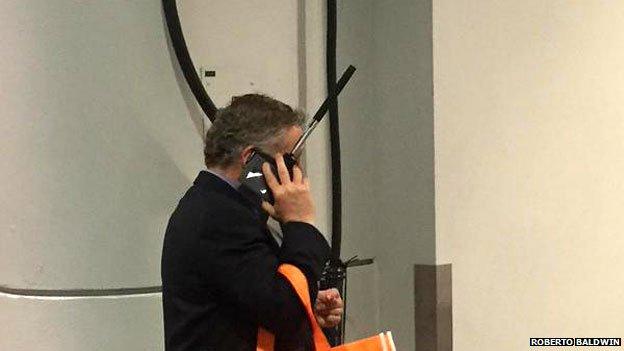
The trouble with selfie sticks: receiving a call mid-pose
He's spent the past decade promoting his invention at trade fairs, on the QVC shopping channel and on TV shows like Dragon's Den. "It was a 10-year 'overnight' success," he says.
Fromm disclosed Ueda's extender in his patent as "prior art", but he believes the current selfie stick craze is a direct result of his own model. "It happened because of my work, and I can show a paper trail of that. There's lots of knock-offs of my product that actually have my daughter's picture on the packaging. The factories have been studying my product all of these years, basically stealing the photos as well," he says.
"This is why I say I invented what we call today's selfie stick."
Fromm's product, unlike Ueda's, has sold well, but there are plenty of others profiting from it too, by producing cheap knock-offs. So many, in fact, that it is impossible to pursue them all.
"It's like ants at a picnic: you can't step on them all. It basically went viral and it would be a waste of my emotional energy to start fighting the world over this sort of thing," he says.
Besides, says Fromm, for inventors like him and Ueda it's not all about the money. "It's that you're actually creating something fun or useful or helpful for people. So I'm happy that the world has embraced the selfie stick."
But has anything been lost? What about that brief interaction between strangers, the kind exchange of a favour? Fromm doesn't miss it. "Once you break silence with strangers," he says, "they feel they have the right to continue to talk to you."

Chindogu
It was while scanning mail-order catalogues that Kenji Kawakami came up with the idea of chindogu - Japanese for "strange tools". He has thought up hundreds of bizarre and absurd items such as funnel glasses (to guide eye drops) or the train nap cap (to avoid head-lolling while asleep on public transport).
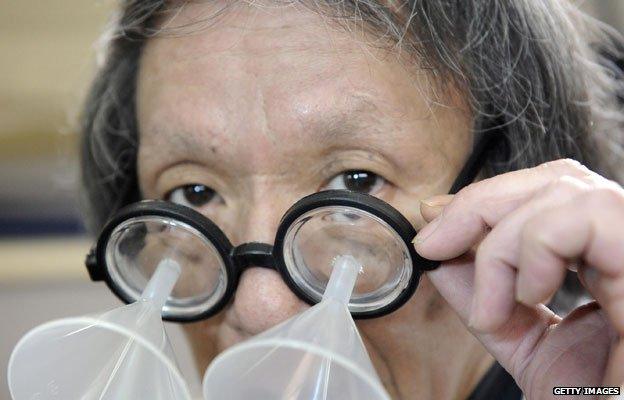
Kenji Kawakami with his funnel glasses
The International Chindogu Society also keeps an eye out for unlikely inventions that are a reality, external - like the suitcase scooter.
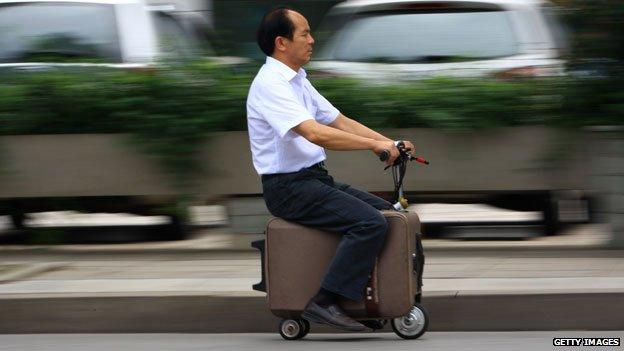
Chinese farmer He Liangcai riding his motorised scooter suitcase - it can travel up to 12.5mph

Hiroshi Ueda spoke to Outlook on the BBC World Service. Listen again on iPlayer or get the Outlook podcast.
Subscribe to the BBC News Magazine's email newsletter, external to get articles sent to your inbox.